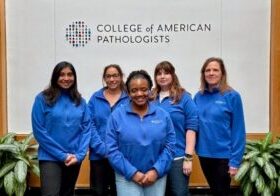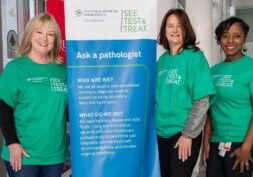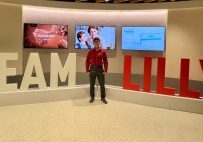Resident Dr. Gregory Dickinson Receives Herbek Award
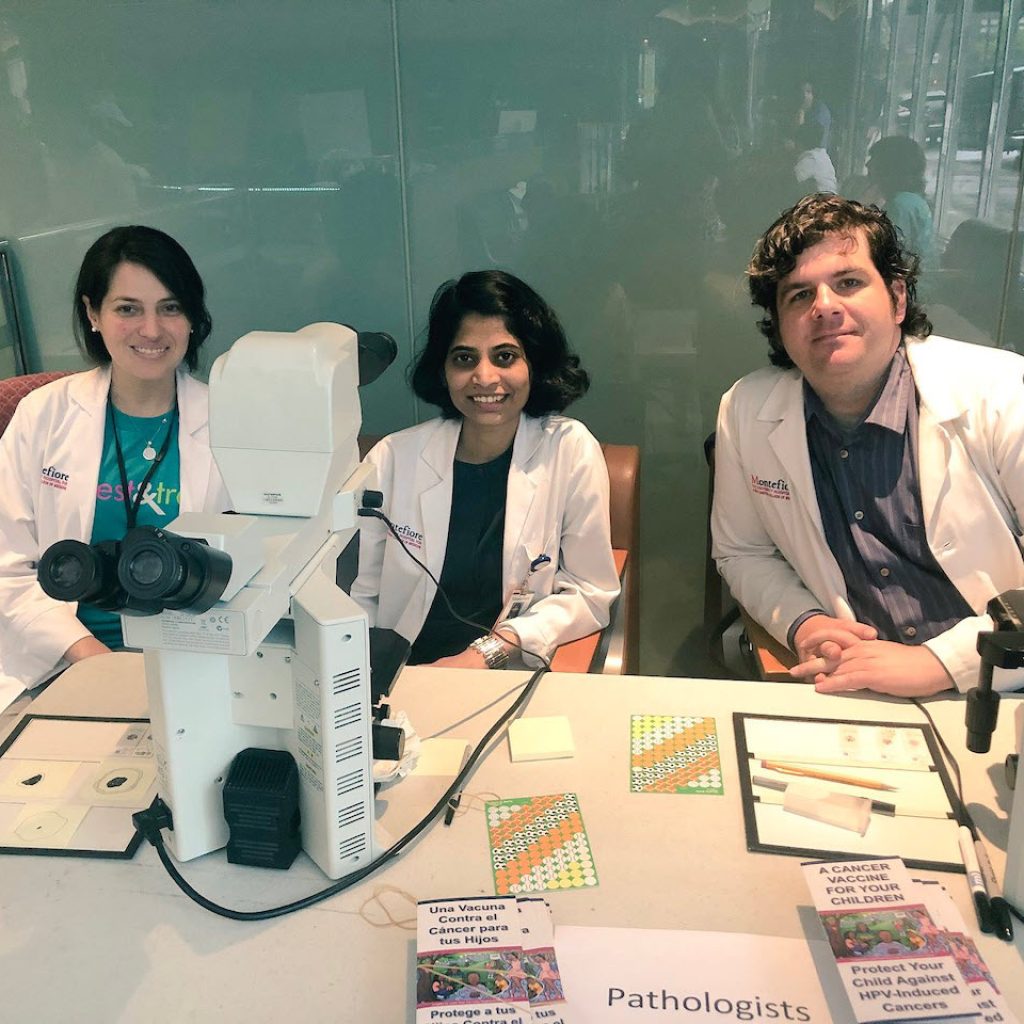
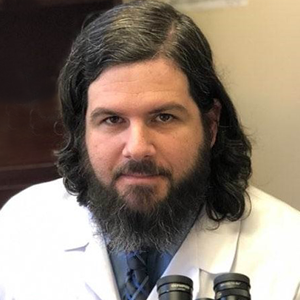
Gregory Dickinson, MD
The CAP Foundation has chosen Gregory Dickinson, MD, to receive the 2020 Gene and Jean Herbek Humanitarian Award. The prestigious award recognizes unique and innovative contributions to advancing See, Test & Treat, a community outreach program that offers free breast and cervical cancer screenings, same-day results, and follow-up care, if needed, for uninsured and underinsured women in medically underserved communities. It also honors those who expand the See, Test & Treat model to other vulnerable populations and teach patients about pathologists and their role as part of the health care team. A June 2020 graduate of Montefiore Einstein’s pathology residency program, Dr. Dickinson is the youngest Herbek award recipient and the first resident to be honored with it.
The award is named for Gene N. Herbek, MD, FCAP, a past president of the CAP who conceived of See, Test & Treat and led the first event, providing free care to Native American women in South Dakota. Though he passed away in June 2020, Dr. Herbek’s legacy and vision are continued by his wife, Jean; Herbek award recipients; and the See, Test & Treat program.
See, Test & Treat is presented by hospitals and other community-based health facilities across the United States to help ensure the delivery of vital health care to women in need.
See, Test & Treat at Montefiore
Working together with colleagues from the departments of radiology, obstetrics, and gynecology and women’s health, the Montefiore Einstein Department of Pathology spearheads a vibrant See, Test & Treat program.
Faculty and trainees, along with an eclectic group of community volunteers (including Einstein medical students who staff the medical school’s free, student-run ECHO Clinic), donate their time and expertise on a Saturday in the spring or fall to deliver potentially life-saving services to women ages 21 to 64 in the Bronx.
Dr. Dickinson’s strong leadership skills came to the fore during his residency as he recruited his peers to join him as volunteer patient educators at See, Test & Treat. His efforts did not go unnoticed, according to Tiffany M. Hebert, MD, FCAP, director of the pathology residency program at Montefiore and an associate professor of pathology at Einstein.
“He was a wonderful resident—a pleasure for his mentors to teach and learn from and an inspiration to his peers who expressed their admiration by electing him chief resident,” Dr. Hebert said.
Mark Suhrland, MD, FCAP, concurs. As director of the pathology department’s cytology division and a professor of pathology at Einstein, he mentored Dr. Dickinson during his residency and nominated him for the Herbek award.
“For three consecutive years, both as a pathology resident and chief resident, Greg consistently demonstrated his deep commitment to supporting and promoting our See, Test & Treat program,” Dr. Suhrland said.
Patient education is an important part of See, Test & Treat. An essential item in the pathologist’s toolkit—the double-headed microscope—is deployed to accomplish this objective. Pathology residents and fellows invite attendees to join them in peering into the lenses of a double-headed “scope” to view Pap specimen slides. Dr. Dickinson and his colleagues initiated discussions with program participants about what they were seeing on the slides, providing lay-friendly descriptions and explanations.
They also distributed educational materials, discussed the importance of routine preventative cancer screening, and explained the role of the pathologist as a member of the health care team, as well as the purpose of diagnostic testing in health care.
As a first-year resident, Dr. Dickinson became intrigued with the double-headed microscope activity. He was convinced of the value of the scope exercise not only as an educational tool, but as a vehicle for team building among trainees and for promoting a sense of community between pathologists-in-training and the diverse patient populations they serve.
Thinking a step further out of the box, he was confident the double-headed scope activity could potentially benefit other patient populations.
Expanding “the Scope” of Pathology Patient Education
“I was raised in a family where if you saw an unmet need, you had an obligation to make yourself useful,” Dr. Dickinson said, speaking of his upbringing in Mission Viejo, California. “Translation: you employ your creativity, ingenuity, and problem-solving skills—and whatever resources are available—and come up with a way to address it.”
In fall 2019, Dr. Dickinson seized an opportunity to do just that. He introduced the double-headed microscope exercise at a prostate cancer-screening event co-hosted by Montefiore and the Men’s Ministry of the Grace Baptist Church in Mount Vernon, New York. The event served a largely African American population.
He invited program participants to join him in viewing slides of tissue samples illustrating different Gleason scores, the grading system used to determine the severity of prostate cancer. Intrigued, attendees lined up to take a turn at the scope.
“When they sat down they would initially ask about the microscope,” Dr. Dickinson recalled.
Then something remarkable happened. “After they learned I was a physician in training, some of the men spontaneously started telling me about their personal relationship to prostate cancer. They shared that they’d had their prostate removed, or that they have a friend with metastatic prostate cancer. One gentleman even wanted to see more histology, so I directed him to the internet.”
A Powerful Teaching Tool
The See, Test & Treat exercise is unique and practical, according to Dr. Dickinson. “You can do it anywhere. All you need is a table, two chairs, and a double-headed microscope. If done correctly, it creates lots of opportunity for valuable public health education experiences.”
In their role as patient educator, he added, pathologists can “take a curious-looking tool and show patients a disease they can’t see with the naked eye. To see a picture of cells in a book or on a screen is one thing, but to see it through the microscope is powerful.”
The double-headed scope exercise, he noted, “allows pathologists to get out of the back room and show patients what’s normally hidden from them. It’s a great way to help them understand what the screening process is all about and the role we pathologists play in helping clinicians render an accurate diagnosis.”
A Deserving Honoree
Dr. Dickinson’s professors and mentors are unanimous in their support of his recognition with the Herbek Humanitarian Award.
“Dr. Dickinson is well-deserving of this honor,” Dr. Suhrland said. “He exemplifies the mission of our institution to advance the values of social justice, combat health care disparities, and ensure access to high-quality, compassionate care for all people, particularly those in underserved communities.”
Michael B. Prystowsky, MD, PhD, FCAP, professor and university chair of pathology, agrees. “We’re extremely proud of Dr. Dickinson’s achievement,” he said. “His groundbreaking initiative was in extending a unique feature of the See, Test & Treat model to African American men, a population at high risk for prostate cancer. That novel effort opened an entire new opportunity for screening an additional underserved population.”
“It was exciting to watch Greg take this concept and run with it,” Dr. Hebert said. “He has a bright future and will help improve the health and well-being of patients and be a credit to our field.”
Dr. Dickinson plans to specialize in forensic pathology. He is currently a first-year fellow in the New York City Medical Examiner’s Office in Manhattan. The winner of the Gene and Jean Herbek Humanitarian Award will be formally announced during the CAP20 annual meeting, to be held virtually in early October.
The content for this article was provided courtesy of Lora Friedman, media content specialist, Montefiore Einstein Department of Pathology.
More Stories
Why Donate
Every person deserves a diagnosis. Support care beyond the microscope. Expand access to pathology-locally and globally.




